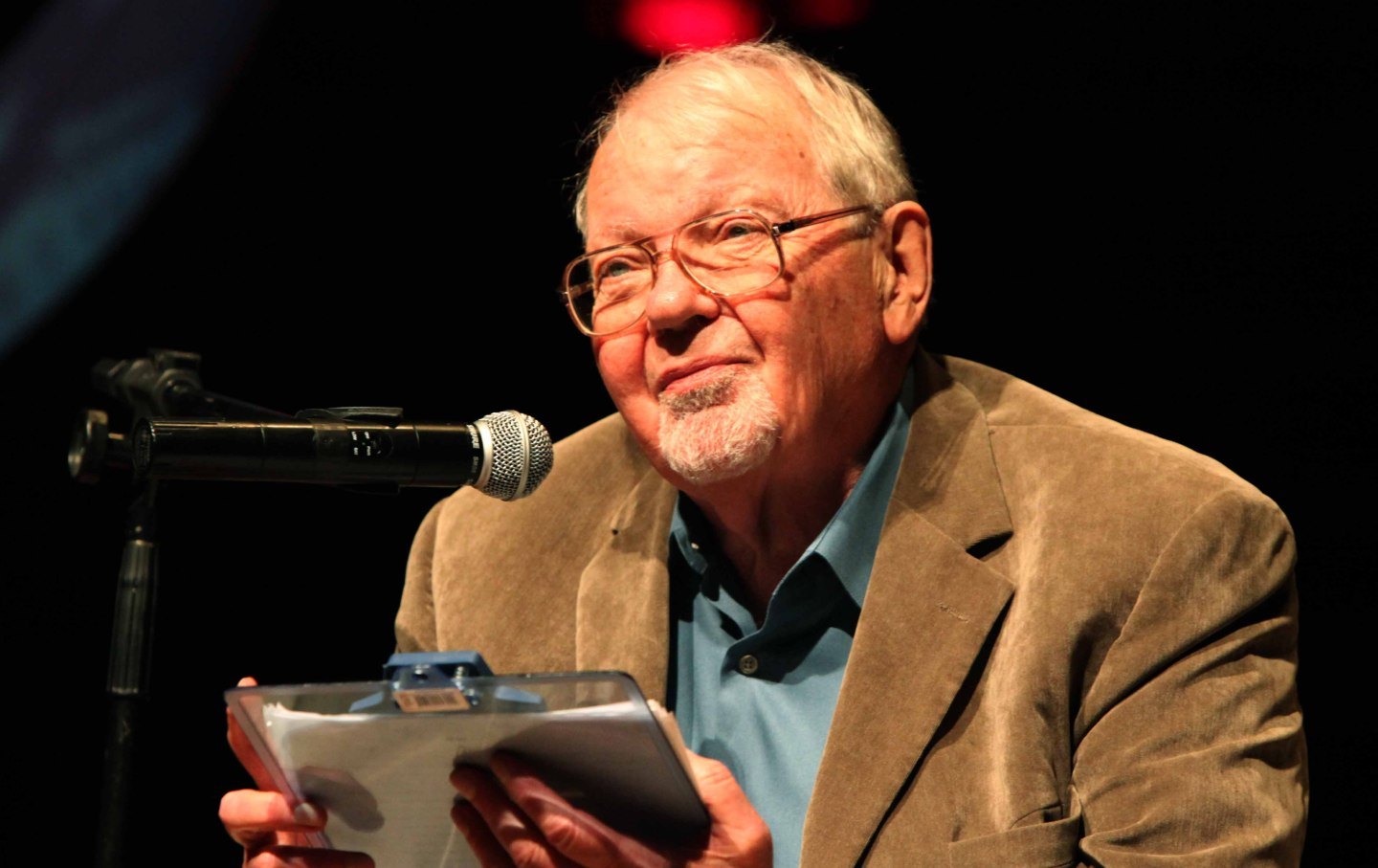Fredric Jameson Named the System We Are Still Fighting
The late literary critic revitalized Marxism to critique our postmodern and globalized reality.

Being a Marxist in America is an often bewildering fate, as the towering literary critic Fredric Jameson, who died last month at the age of 90, discovered in 1991. That’s when he learned that, nearly two decades earlier, he and his friends had been denounced to the FBI by a writer he cherished and championed, Philip K. Dick.
In the early 1970s, Dick was far from the largely posthumous fame he would garner via Hollywood adaptations (starting with Blade Runner, released in 1982 shortly after his death). Even more distant was the eventual canonization of Dick by the literary establishment that would see his science fiction novels enshrined in elegant volumes by the Library of America.
Dick in the 1970s had suffered all the indignities of being a working-class pulp writer: His books were usually brought out as schlock paperbacks by a notoriously sleazy publisher, Ace Books, that routinely ripped him off. To keep afloat, he had to write at a frenzied, amphetamine-fueled pitch, producing five novels in 1964 alone. This feverish writing and substance abuse poisoned Dick’s personal life (a string of failed marriages and short-term relationships) and his mental health. By 1974, he was seeing visions from a pink light he named VALIS, which he suspected might be God, the CIA—or perhaps space aliens.
With his life in crisis and possessing only the most marginal of literary reputations, Dick might have welcomed the stirrings of critical praise he was starting to receive from a group of radical scholars clustered around the new journal Science Fiction Studies, founded in 1973. These scholars, led by Darko Suvin and Fredric Jameson, upheld Dick as visionary whose gift for loopy world-building (alternative histories and imagined futures that didn’t gleam and shine in the manner of a Star Trek episode, but were as compulsively destabilizing and logic-challenging as a nightmare or a bad drug trip) embodied the new world of consumer capitalism, media manipulation, psychological breakdown, and psychedelic experimentation. The criticism of the Science Fiction Studies group, along with more journalistic advocacy by Paul Williams in Rolling Stone, laid the foundation for Dick’s gaining recognition as a major writer.
In 1974, Jameson and a group of other Dick admirers (including the science fiction writer Norman Spinrad, the literary critic Peter Fitting, and the critic and musician Richard Pinhas, who was accompanied by his wife, Agenta) visited the writer at home in Fullerton, California. It was a genial day, with much beer was downed amid friendly disputes about the meaning of Dick’s work. Dick flirted with Agenta Pinhas, as her husband looked on, gamely trying to speak to her in primitive pidgin German. Dick thought that she, as a Swede, should be able to catch his meaning.
But after his guests left, Dick succumbed to paranoia. He was influenced not just by his VALIS delusions but also living in Cold War America: In the early 1950s, the FBI had tried to recruit Dick and his wife to spy on students at Berkeley. Dick’s correspondence with a Soviet scientist had been read by the government. His house had been burglarized, something he suspected the FBI might have had hand in.
Worried that being championed by avowed Marxists such as Jameson and Fitting might lead to further persecution, Dick wrote a missive to the FBI describing an elaborate (and wholly imaginary) conspiracy masterminded by the Polish science fiction writer Stanislaw Lem “to gain monopoly positions of power from which they can control opinion through criticism and pedagogic essays,” which he described as “a threat to our whole field of science fiction.” Dick would write further letters along this line in the following year, not all of which he mailed.
Dick’s relationship with his Marxist critics, like everything else about him, was complex and tortured. In 1975, Science Fiction Studies published a special issue on Dick, which included Jameson’s incisive analysis of world-building in the novel Dr. Bloodmoney (1965). Dick responded with particular enthusiasm to this essay, describing Jameson as “brilliant.” Writing to Darko Suvin, Dick said Jameson’s critique gave him “such pervasive new insight into my own head and my own work, that it may fundamentally change what I am capable of doing.”
Ultimately, Dick’s two-faced behaviour was bizarre and sad, worthy of pity rather than anger. What’s more notable is the equanimity and good grace with which Jameson (as well as the others Dick denounced) responded to it. In his 2005 book Archaeologies of the Future: The Desire Called Utopia and Other Science Fictions, Jameson included three substantial appreciative essays on Dick, including one written after Dick’s correspondence with the FBI became public. In one piece Jameson described Dick as nothing less than “the Shakespeare of Science Fiction.”
Born in 1934, Jameson himself grew up in Cold War America and knew that knee-jerk and unreasoning suspicion was the common response to invocations of Marx and Marxism. This was as true within academia as it was among mass-market writers such as Dick. Jameson himself had not been trained by Marxists but rather by stalwarts of mainstream literary scholarship. His mentors were Erich Auerbach, the chronicler of mimesis; Leo Spitzer, the explorer of stylistics; and Wayne Booth, the ethics-minded analyst of irony. Jameson’s encounter with Marxism was extracurricular: the byproduct of his studies of Jean-Paul Sartre, the subject of Jameson’s doctoral thesis and first book. Studying Sartre and traveling in Europe on a Fulbright, Jameson encountered a wealth of European Marxists whose work was largely unknown (or suspiciously regarded) in Cold War America.
Their dubious reputation left Jameson neither daunted nor timid. He was Marxist of a Hegelian bent: He knew there was no point in refuting an alternative system if you didn’t also absorb what was true in it. To understand capitalism, Marx himself carefully studied—critically, but also with an eye for what was sound—liberal economists such as Adam Smith and David Ricardo, as well as the reactionary and royalist novelist Honoré Balzac. From this great French novelist, as Friedrich Engels enthused, “I have learned more than from all the professed historians, economists, and statisticians of the period together.”
As Jameson noted in the preface to his first important book, Marxism and Form (1971), even friendly non-Marxists saw it as a tradition that was both foreign and antiquated, “over and done with as a living and developing philosophy.” These strenuously up-to-date critics dismissed Marxism as belonging to “the atmosphere of the 1930s,” which “no longer correspond to the conditions of the world today.” What did Marxism, a leftover from the Industrial Revolution, have to do with the postwar world of consumer abundance, all-pervasive media and advertising, waning class consciousness, our increasing focus on therapeutic as against economic problems, and the fragmentation of collective life into ever smaller shards of personal experience?
Jameson’s response to this challenge was twofold. His first task was to recuperate and make more popular the robust European tradition of Western Marxism that, although obscure in the anglophone world, was in fact fully engaged in describing the realities of contemporary life. In Marxism and Form, Jameson became one of the best advocates in the English-speaking world for those Marxists who described the lived experience and cultural manifestations of contemporary life: T.W. Adorno, György Lukács, Walter Benjamin, Herbert Marcuse, Ernst Bloch, and Sartre.
Jameson’s achievement, as Perry Anderson noted in The Origins of Post-Modernity (1998), was to bring these writers (and more) together for a “formidable synthesis” in his own work. These were thinkers often in disagreement on key points: For example, Adorno’s suspicion of cultural industries as manipulative propaganda in the service of big business stood in conflict with Bloch’s account of the utopian aspirations that pervade that same mass culture. Jameson was not one to try to smooth over contradictions. In the film criticism collected in Signatures of the Visible (1993), James demonstrated that an tense interplay between status quo ideology (“reification” in Marxist terminology) and liberatory fantasies (“utopia”) played itself out in movies such as Jaws and the Godfather films, a remarkable fusion of the seemingly antithetical views of Adorno and Bloch.
As Anderson marvels, Jameson somehow managed to absorb into his work the many disparate gifts of earlier Western Marxists:
From Lukacs, Jameson took his commitment to periodization and fascination with narrative; from Bloch, a respect for the hopes and dreams hidden in a tarnished object-world; from Sartre, an exceptional fluency with the textures of immediate experience; from [Henri] Lefebvre, the curiosity about urban space; from Marcuse, pursuit of the trail of high-tech consumption; from Louis Althusser, a positive conception of ideology as a necessary social imaginary; from Adorno, the ambition to represent the totality of his object as nothing less than a “metaphorical composition.”
To distill Western Marxism into a unified worldview is by itself an imposing feat, but only one half of the Jamesonian equation. If you want to be a fully dialectical thinker, which was Jameson’s goal, you can’t be satisfied with just the statement of one side: You have to incorporate the opposition, learn from the antithesis, and find the truth in the negation.
The follow-up to Marxism and Form was The Prison-House of Language (1972), which took up the distinguished body of post-Marxist and anti-Marxist thought that emerged out of Russian formalism and French structuralism (which was already morphing into post-structuralism even as Jameson was writing about it). Emblematic thinkers in these traditions included Roland Barthes, Michel Foucault, Julia Kristeva, and Jacques Derrida.
These writers rejected historical analysis in preference for a focus on language and signs, webs of communication that had to be looked at in synchronic terms (e.g., outside of historical development) as a whole.
Popular
“swipe left below to view more authors”Swipe →Many stick-in-the-mud Marxists were, with good reason, wary of this “linguistic turn,” which they decried as the path to political retreat and obscurantism. Jameson, though, was confident enough in his Marxism to grapple with non-Marxist and anti-Marxist thought and incorporate it into his system. The formalist technique of close textual reading of literary works is usually seen as antithetical to the Marxist goal of seeing art in its historical context. What Jameson proved in a myriad of essays on writers as varied as Balzac, Marcel Proust, and Gertrude Stein is that he could do close reading with the best of them in the service of historical analysis. Marxism furnished the unsurmountable horizon—indeed, a horizon wide enough to encompass the whole human adventure—but under that horizon, rival systems could be enriching.
All this dizzying playing with theories and philosophies was no mere intellectual parlor trick but in the service of a vital project: the revitalization of Marxism so it could describe the new multinational capitalism that gained dominance after World War II and remade global culture as surely as it did economics. Marx, child of German Romanticism, saw capitalism in terms of Gothic metaphors like vampires, werewolves, and ghosts. Jameson, living in the age of big-budget Hollywood spectacles, saw capitalism as something more akin to the shape-shifting cyborg from Terminator II: Judgment Day (1991): a fluid, adaptive predator that constantly regenerates itself despite all attempts to kill it.
To describe this new incarnation of the monster, a fresh vocabulary and conceptual tool kit was needed. Hence the effort Jameson put into elevating, recasting, and refining such terms as “late capitalism,” “neoliberalism,” “postmodernism,” and “globalization.” These words are now part of the everyday vocabulary of tens of millions of opponents of capitalism around the world—not just academics but activists of all stripes. This is the legacy of Jameson more than anyone.
In his effort to map out the contours of the historical present and contemporary culture, Jameson had to contend with the reality that the hegemonic thought of our time rejects the relevance of history. Margaret Thatcher assured us that there was no alternative to the dictates of the market, and Francis Fukuyama was confident that history had come to an end. If those premises are true, then the past is only of antiquarian interest, since that means our contemporary capitalism isn’t a contestable system but simply the natural and inescapable order of things. Tweaking a phrase from fellow Marxist and science fiction fan H. Bruce Franklin, Jameson summed up this attitude by saying, “It is easier to imagine the end of the world than it is to imagine the end of capitalism.”
Jameson was attracted to the works of Philip K. Dick because his books were suffused with a sense of the strangeness of the new capitalism, a world that wasn’t natural but disorienting in its production of media-saturation and simulacra, artifacts that invaded not just the physical world but our inner life. Dick, by Jameson’s account, was the novelist par excellent of postmodernism. In a 1982 obituary for Dick, Jameson noted:
[It] is the related theme of reproduction and of the production of copies that makes Dick’s work one of the most powerful expressions of the society of spectacle and pseudo-event, in which “the image is the final form of commodity reification”, as Guy Debord puts it in The Society of the Spectacle. For Dick was also the epic poet of drugs and schizophrenia of a 1960s counterculture (not excluding the gnostic mysticism that he propounded insistently in his final years, after the renunciation of the drug culture in A Scanner Darkly, in 1977).
But beyond his forays into drug-induced reality breakdowns, Dick was also a post-individualist who gave us narratives “in which the collective makes a fitful and disturbing reappearance, most often in a paralyzed community of the dead or the stricken, their brains wired together in a nightmarish attempt to find out why their familiar small-town worlds are lacking in depth or solidity, only to discover that they are ‘in reality’ all immobilized together in some cryogenic half-life.”
Two years after Dick died, Jameson published his famous essay “Postmodernism, or the Cultural Logic of Late Capitalism.” Some of the key ideas that Jameson explored here, and in his other vastly influential studies of postmodernism, emerged out of his contentious engagement with Dick. Whatever Dick’s politics might have been, he gave Jameson an imaginative framework for understanding postmodernism as the cultural dominant that took hold as the classical capitalism of industrialism and extraction gave way to late capitalism and globalism.
Jameson’s engagement with Dick not only informed his own work but arguably changed the science fiction genre itself. In 1982, a graduate student named Kim Stanley Robinson finished a doctoral thesis on Philip K. Dick that first started under Jameson’s supervision (although it was completed under Donald Wesling after Jameson moved to another university). In both the doctoral thesis and, more importantly, in the many top-notch science fiction novels he would write, Robinson showed the pervasive influence of Jameson’s work—in particular the creation of futures and alternative histories that show how history, far from being exhausted, remains the battleground of competing classes. Robinson’s work reveals a persistent search for utopian possibilities even in the most dismal situations.
It’s impossible to do justice to Jameson’s contribution in a short tribute. He was often described as America’s greatest Marxist literary critic. This might have been adequate in the 1970s, but soon became too narrow as he expanded the reach of his thinking. Far from being just a literary critic, Jameson wrote with equal authority on architecture, film, and painting, among other fields. Far from his being just an American, his work had a global scope. He wrote about the cultural productions of Russia, China, Japan, the Philippines, Senegal, Venezuela, and many other lands. His work has likely been more intensely studied in Asia and Latin America than in his native land.
Death at age 90 can hardly come as a shock. But then Jameson was an exceptional case. He remained astonishingly productive until the end, with three books published this year alone. Until he was incapacitated by a fall over the summer, he had been scheduled to teach at Duke this year. In his most recent writing, he remained an active, living voice, engaging with new subjects and authors while also revisiting old favorites, such as Sartre, with fresh eyes.
Marx will be read as long as capitalism exists; the same is true of Jameson. Defending himself in 1989 from fellow Marxists unhappy with his writing on postmodernism, Jameson cited the old adage from Students for a Democratic Society in the 1960s: “We have to name the system.” No one was better at naming the system than Jameson.
Support independent journalism that exposes oligarchs and profiteers
Donald Trump’s cruel and chaotic second term is just getting started. In his first month back in office, Trump and his lackey Elon Musk (or is it the other way around?) have proven that nothing is safe from sacrifice at the altar of unchecked power and riches.
Only robust independent journalism can cut through the noise and offer clear-eyed reporting and analysis based on principle and conscience. That’s what The Nation has done for 160 years and that’s what we’re doing now.
Our independent journalism doesn’t allow injustice to go unnoticed or unchallenged—nor will we abandon hope for a better world. Our writers, editors, and fact-checkers are working relentlessly to keep you informed and empowered when so much of the media fails to do so out of credulity, fear, or fealty.
The Nation has seen unprecedented times before. We draw strength and guidance from our history of principled progressive journalism in times of crisis, and we are committed to continuing this legacy today.
We’re aiming to raise $25,000 during our Spring Fundraising Campaign to ensure that we have the resources to expose the oligarchs and profiteers attempting to loot our republic. Stand for bold independent journalism and donate to support The Nation today.
Onward,
Katrina vanden Heuvel
Editorial Director and Publisher, The Nation
More from The Nation

Why “The Living Mountain” Endures Why “The Living Mountain” Endures
Nan Shepard’s classic of nature writing and memoir is an education in how to reorient one's attention to a landscape and its lifeforms, human and nonhuman.

The Making of a Cold War Spy The Making of a Cold War Spy
The life and work of Frank Wisner, one of the CIA’s founding officers, offers us a portrait of American intelligence’s excesses.

The Workplace Nightmares of “Severance” The Workplace Nightmares of “Severance”
The appeal of the Apple TV+ series is how it dramatizes our alienation from labor.

How Atlanta Became a Walkable City How Atlanta Became a Walkable City
The Beltline and Georgia's experiment in pedestrian spaces.

The B-Sides of the “Golden Record,” Track Eleven: “How Will You Begin?” The B-Sides of the “Golden Record,” Track Eleven: “How Will You Begin?”


